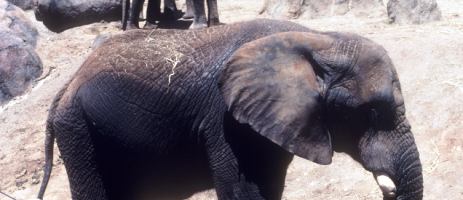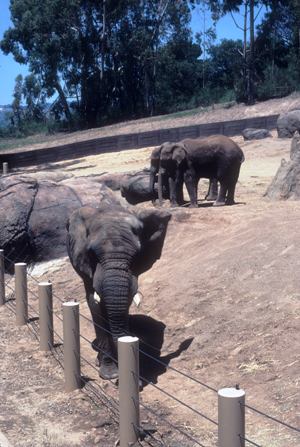
The Myth of the
Wild
By
Brenda Scott Royce, December 27, 2008

My
last post here, about the efforts by animal
activists to halt construction of the
Los Angeles Zoo's new elephant habitat, sparked more debate than
anything I've previously written. As I've followed the firestorm of comments
here and in other media outlets, I've been increasingly struck by what has
become the rallying cry of Los Angeles's anti-zoo crowd: "Free Billy."
It's cute and catchy, but utterly disingenuous.
"Billy" is a 24-year-old Asian elephant who has resided at the Los Angeles
Zoo since 1980 [correction: 1989]. For the past few years he's been the
unwitting star of a battle between the Los Angeles Zoo and animal rights
activists over the construction of the zoo's new elephant habitat. The
Pachyderm Forest project is 30% complete, but work has been temporarily
halted while both sides fight it out in L.A. City Council chambers.

But the people filing into City Hall wearing "Free Billy" T-shirts and
stickers aren't actually calling for his return to the wild. No one is
advocating unlocking the zoo's gates and allowing the massive pachyderm to
roam freely in Griffith Park. Nor are they suggesting he be airlifted to
Malaysia, the country of his birth, and dropped off in what little remains
there of the wild. (If that were the case, experts on both sides of the
issue would surely agree his prospects for survival would be bleak.)
No, the acknowledged goal of the "Free Billy" petitioners is to send Billy
to an animal sanctuary. And that's what has me scratching my head.
Sanctuaries, like zoos, are captive environments -- captive environments
that by and large have
fewer resources and are subject to less rigorous
scrutiny and accreditation standards than zoos. As I've stated
before, there are good sanctuaries and bad ones, but any way you look at it,
the animals living in them are not free.
Moreover, sanctuaries do not allow their animals to breed, thus they are not
concerned with perpetuating species -- something that is central to the
mission of modern, accredited zoos. American zoos not only participate in
species survival programs, they also support more than 80 elephant
conservation and research projects worldwide, including habitat restoration
and reduction of human-elephant conflict. The L.A. Zoo,
Billy's home,
supports Asian elephant conservation through Fauna & Flora International. AZA-accredited zoos also provide the majority of support for the
International Elephant Foundation.

Most animal lovers would agree they'd prefer that exotic animals live in the wild than in captivity. But with our planet increasingly in peril, how many truly wild places remain? When Americans travel to "the wild" to see animals firsthand, it is more often than not via guided tours to protected reserves in Africa or Asia. Thanks to deforestation, climate change, and human encroachment, the wild as we once knew it is a myth. Wild places are fast disappearing, and the wildlife they once supported is at ever-increasing risk. A recent report by the International Union for the Conservation of Nature showed that one in four mammal species is in danger of extinction. Billy's native Malaysia is experiencing rapid deforestation, with less than 20% of primary forest cover remaining.
The romanticized notion that animal sanctuaries are synonymous with freedom
is not only deceptive, but dangerous. It diminishes the threats faced by
wild species and makes us complacent to statistics like those cited above.
Equating sanctuaries with freedom (or equally erroneously,
zoos with
prisons) also serves to polarize people who might otherwise be working on
the same side, toward survival of the species and preservation of what
precious little remains of "the wild."
Reprinted With Permission © Copyright 2008
Brenda Scott Royce
Photo Copyright © REXANO 2009
Photos on this page are from AZA zoo, but not from L.A. Zoo.
www.REXANO.org